Modes of Fossil Preservation
Callan Bentley, Karen Layou, Russ Kohrs, Shelley Jaye, Matt Affolter, and Brian Ricketts and Charlene Estrada
Unaltered remains
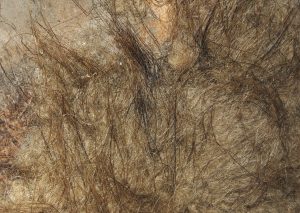
An amazing diversity of fossils exist in a relatively unaltered state. While there may be some compression of the fossil material due to the burden of burial sediments above, or separation of individual shells or bones, unaltered remains are skeletal components preserved in their original mineral composition. It is important to have a general sense of what the expected mineralogy of a fossil organism should be to determine whether another mode of preservation could apply to the specimen.
| Common fossil mineralogy | Common organisms |
| Calcite (CaCO3) | Foraminifera, coccolithophores, sponges, tabulate and rugose corals, brachiopods, bryozoans, trilobites, mollusks, echinoderms. |
| Aragonite (CaCO3) | Modern (scleractinian) corals, mollusks |
| Quartz (SiO2) | Radiolarians, diatoms, sponges |
| Hydroxyapatite Ca5(PO4)3 | Vertebrate bone and teeth |
Soft tissues, such as skin, feathers, or fur, may be preserved in some exceptional cases. This type of preservation does not typically occur within sediments but in materials like amber or glacial ice.
Permineralization
Permineralization occurs when open spaces within porous tissues are filled in with mineral crystals after the skeletal material of the fossil has been buried. Groundwater containing dissolved minerals passes through the buried fossil, and minerals grow in the available space when that water evaporates. Typical infilling minerals include quartz, calcite, and iron oxides, all common cementing minerals for sedimentary rocks.
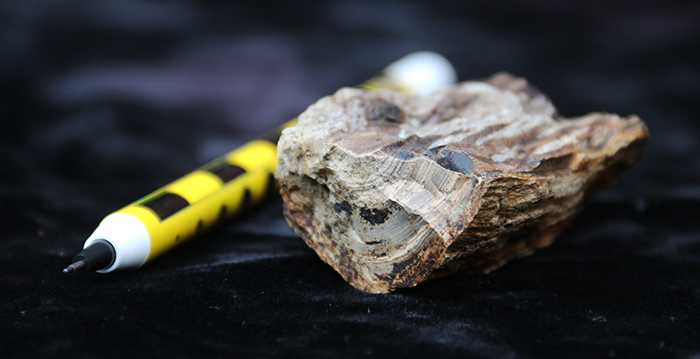
Permineralization is a common mode of preservation for vertebrate bones and wood but can also occur in some shells. In the case of petrifaction (“petrified” wood), minerals fill the porous spaces in the plant tissues and replace the organic material of trees. Permineralized fossils maintain a high degree of detail, as they preserve both internal structures and the three-dimensional shape of the original organism. Because crystal growth occurs in the prior open spaces within the skeletal material, permineralized fossils tend to be denser and heavier than their original counterparts.
Carbonization
When soft tissues are quickly buried in quiet water, they are subjected to increased pressure and rising temperatures as part of the lithification process. These conditions affect the remaining organic material, resulting in a process that releases chemically volatile compounds. When the volatiles are released, a dark-colored film of chemically stable carbon is left behind. Intricate details of delicate soft tissues may be preserved, including individual cell structure in plants, fish scales, insect wings, and even internal organs.

Replacement
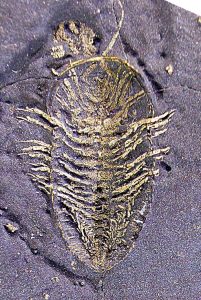
The increased pressure and temperature conditions in sediments’ deep burial liberate trapped fluids containing mobile chemical ions. The fluids interact with buried fossils and may completely dissolve the original mineral or organic material, replacing it with different ions that precipitate from the circulating fluids. Common replacement minerals include silica and pyrite. The decay of organic material requires bacterial support, which can reduce sulfur and precipitate the iron sulfide mineral, pyrite. Often, the original organism’s detail can be preserved via replacement.
Recrystallization
Recrystallization is an important process that preserves fossils made of aragonite, a common but chemically unstable mineral over geologic time. Many marine invertebrates (molluscs, modern corals) have a metabolism that allows them to crystallize aragonite as their skeletal material. Aragonite is a polymorph of CaCO3 (meaning that it and a few other minerals are made of this material), and it sometimes appears as a beautiful “mother of pearl” on the inside shells.

But outside the organism’s living tissue, aragonite is less chemically stable than calcite, so it spontaneously recrystallizes to make calcite after burial. This calcite “version” of the shell is more likely to last long enough to enter the geological record and be discovered by geologists. There is no change to the chemical formula of the mineral during recrystallization, just the same atoms reconfiguring into a more stable crystal structure. This preserves the overall shape of the fossil, but recrystallization can destroy some finer details as new crystals form.
Internal molds
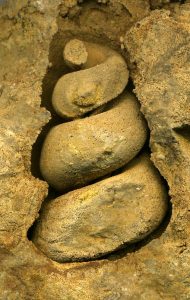
When the interior space of an organism is buried and filled with sediment that is then lithified, the interior shape is preserved as an internal mold. Imagine making a sand castle at the beach, filling a plastic bucket with wet sand, then inverting it onto the ground and lifting the bucket away. The shape of the inside of the bucket is preserved through the bucket itself is gone–that’s an internal mold. In geology, this preservation mode is usually found in bivalves, brachiopods, or snails with a single open chamber where sediment can get in and work its way into the entire space. This preservation mode can reveal lovely impressions of internal features like muscle scars. Still, since most mollusks (i.e., bivalves like clams) are more readily identified using external ornamentation, the loss of the original shell can make things tricky for paleontologists.
External molds
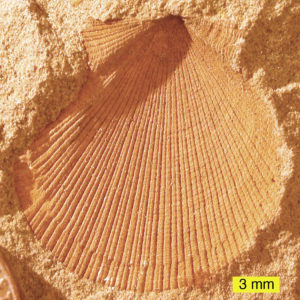
An external mold is an impression of an organism’s outside shape. This preservation commonly occurs when a fossil is pressed into soft sediment. The original hard parts of the organism may then be transported away by currents, or after burial and lithification, the original hard parts may dissolve. When external molds are discovered, the observer sees a version of the exterior of that organism, but it is not a perfect replica because it shows negative relief. Negative relief means that on the impression, raised areas represent indentations on the original fossil, while depressed areas represent raised areas. If you have ever walked along a beach, turned, and examined the footprints you left behind, these are negative impressions of your feet. If that sand could lithify instantly, it would represent an external mold of your foot.
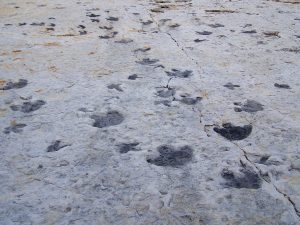
Fossil trackways, a type of trace fossil, are a type of external mold. Some very famous dinosaur tracks are preserved in this way. Most often, external molds are created by hard shells or bones. However, some external molds of dinosaur skin have been discovered, meaning that even soft tissues can be preserved via this mode under the right conditions.
Casts
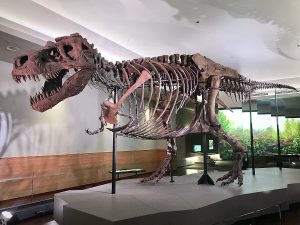
Casts are replicas of organisms, essentially recreating their original shape. First, an organism must be preserved as an external mold, or perhaps open burrows preserved as trace fossils. The impressions or other cavities are then filled in with sediment, producing a three-dimensional form that mimics the form of the original fossil. Imagine if you took some clay and pressed it into the external mold of the trilobite above. Once hardened, you could pop that trilobite out and have a cast of the original fossil, mimicking its original form, and presented in positive relief. Some details are typically lost when a cast is created but can still provide critical information about the organism.
Interestingly, many fossil skeletons on display at museums are primarily casts. This doesn’t mean the fossils are fakes since the casts are created based on the original fossils. Casts are used for many reasons: the original fossils can be hundreds of pounds of permineralized bone, making it a challenge to mount the specimens, the originals may be fragile and require a controlled environment for preservation, and it is a way to share specimens among museums, or the fossils may currently be under study.

